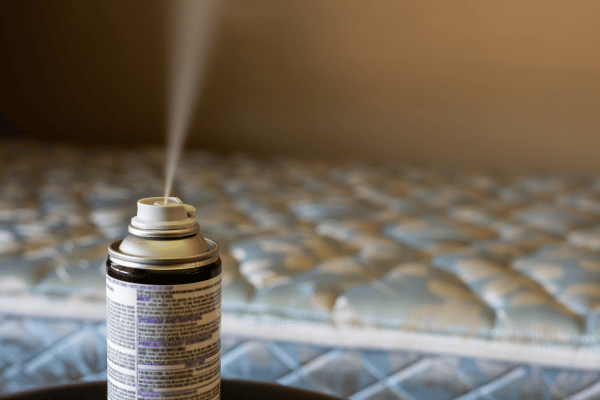- Home
- Outdoor Pests
- Get Rid of Earwigs
Get Rid Of Earwigs
This post may contain affiliate links so I earn a commission.
If you’re looking for tips on how to get rid of earwigs, you’ve come to the right place.
These little bugs might look terrifying, but really, they’re mostly harmless.
Despite their menacing-looking pincers, they rarely use them on people.
Instead, these appendages are used mostly for defending themselves from other insects.
However, that’s not to say that you need to accept an earwig infestation in your home!
If these pests are coming inside your house, it’s important that you get them out as soon as possible.
Here are some tips that will help you get rid of your earwig problem.....for good.
What Are Earwigs And Why Are They A Problem?
Earwigs are small nocturnal insects that prefer to inhabit warm, damp areas.
In their natural environment, earwigs hang out in woodpiles, under mulch, and in crawl spaces under homes.
However, if they come into your house, it’s probably because they’re trying to escape from weather that is overly dry or cold.

Sometimes, they will also come indoors in search of food.
Occasionally, they come inside for no other reason than that
they entered by accident!
These pests were introduced into the United States around 1907.
With more than 20 species of earwigs in the country, rest assured that you don’t need to worry about an earwig biting you.
They would rather eat dead, decaying plants along with small bugs like aphids, grubs, maggots, and army worms.
Earwigs aren’t usually a problem inside the house - they're just creepy.
For most people, this is motivation enough to want to get rid of them.
However, when their populations are allowed to flourish inside the garden, they can be problematic.
Here, they are known to attack living plants like ornamentals, fruit trees, and vegetables.
They are fond of vegetables like lettuce and celery in particular.
Signs Of An Earwig Infestation
Earwigs are most commonly found wherever there is water.
You may see earwigs or signs of earwigs around laundry rooms, bathrooms, and kitchens.
Occasionally, they’ll make their way into other living spaces, like bedrooms - but this is rare.

If earwigs are wreaking havoc in your garden, you may notice that your plant leaves look as though they are full of holes.
You might also find that your plants are covered in black earwig excrement too.
You’re more likely to spot damage after periods of
rainy weather, and you may find them hiding out under plant containers, too.
How To Prevent Earwigs
Check On Your Drainage
Again, earwigs like water. Make sure you do your best to dehumidify moisture-prone areas, like basements or bathrooms.
Check on your outdoor drainage, like downspouts and gutters, to make sure they drain away from the foundation, too.
Keep Things Clean
Make sure your indoor and outdoor areas are clean. Move away any logs, decorative stones, or firewood piles that are close to the house.
Try to keep conditions near the foundation of the home as dry as possible to prevent attracting earwigs.

You may also want to trim any overhanging branches.
These can create damp areas near the home that attract earwigs and
other pests.
Switch Up Your Exterior Lighting
If you’re worried about earwigs, consider how you are positioning your outdoor lighting.
Adjust them so that they shine onto the house from the yard.
The earwigs will be attracted away from the light.
You can also change to yellow bulbs, as white
bulbs tend to be more attractive to earwigs and other insects.
How To Get Rid Of Earwigs
In the home, the easiest way to get rid of earwigs is to remove potential attractants - but if earwigs are problematic in your garden, you’ll have to take more advanced steps to get rid of them.
Make Earwig Traps
Start by laying out one-foot sections of garden hose in the beds between your plants.
These will attract earwigs and you can empty them each morning.
To dispose of the earwigs you caught, dump them into a bucket of soapy water.

You can also make a trap out of soy sauce and vegetable oil.
Combine equal parts of both before putting the mixture in a small plastic container.
Secure the lid, then punch holes in the top (large
enough to allow an earwig through).
Bury your container in the soil, just up to the holes.
The soy sauce will attract the pests and the oil will make it impossible for them to escape.
Create a Plant Barrier
You can also use petroleum jelly to form a barrier around your plants.
The earwigs won’t be able to crawl over it.
Use Diatomaceous Earth
Diatomaceous earth is an incredibly effective treatment for earwigs. It is made out of the fossilized skeletons of microorganisms.
It is only harmful to soft-bodied insects, like earwigs.
All you have to do is sprinkle a bit around the base of your plants. You may have to reapply in rainy weather.

If earwigs are getting into your home, you can also use diatomaceous earth around the potential entrypoint.
It is not harmful to pets or children.
Try Neem Oil To Get Rid Of Earwigs
Neem oil, made out of the oil from a certain tree in India, can repel all kinds of insects.
It contains a natural chemical that affects the hormonal balance in earwigs.
It’s safe to use in both the home and garden and won’t affect beneficial insects or wildlife.
Combine a teaspoon of neem oil with a quart of warm water and put it in a spray bottle.
You can administer the treatment anywhere in which earwigs are a problem.
Attract Natural Predators
Birds love munching on earwigs! Plant a bird-friendly garden with lots of flowers and you should be able to keep these pests at bay.
You can also put a few bird feeders where you've noticed heavy populations of earwigs.
Get Rid Of Earwigs - Overall
Earwigs are easy to get rid of with most of the natural treatments mentioned above.
However, if you find they’re getting on your last nerve, you may need to resort to more aggressive treatments.
Consider contacting a pest control company if you want to use a more aggressive insecticide to get rid of earwigs.
Insecticides aren’t usually necessary for earwigs, so it might be best to get the opinion of a pro before you try these out.
Most of the time, earwig problems can be halted with simple, chemical-free solutions.
The frustration is understandable though - earwigs are certainly creepy!
Nightmares be gone - these tips on how to get rid of earwigs will help you make quick work of the removal of these pests.



